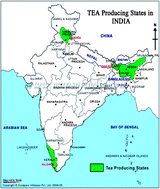Isotope signature study of the tea samples produced at four different regions in India
Abstract
India ranks second in the world for tea production and is well known for Darjeeling tea, which has great demand in the world market due to its unique flavor. In the present study, the combination of isotopic composition of Sr (as 87Sr/86Sr) and C (as δ13C) was studied as geographic tracing signatures for Indian tea samples grown in different regions. Authentic tea leaves as well as soil samples were collected from different tea producing regions; namely, Assam, Darjeeling, Munnar and Kangra, which are geographically distinct from one another. Isotopic analyses were performed by Multi-Collector


 Please wait while we load your content...
Please wait while we load your content...